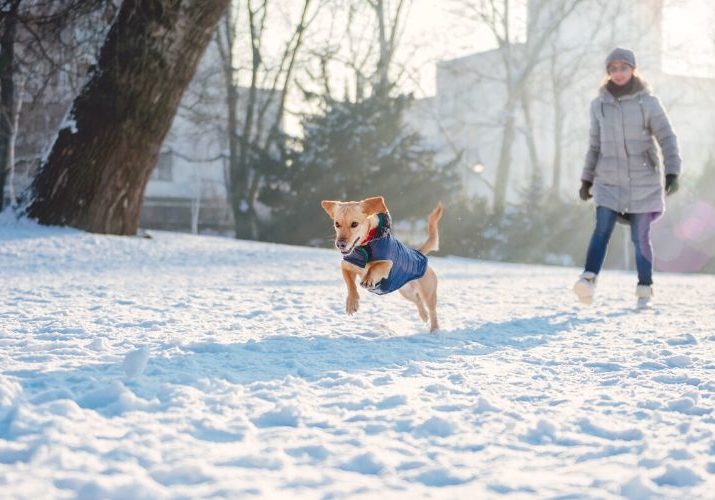Top Safety Tips for Walking Your Dog in Winter
Brrrr! It’s getting a little cold out there isn’t it? Since the recent temperature dips, I’ve had several doggy owner clients (and friends and family) asking me things like:
- Is it ever too cold to walk my dog?
- What’s a safe temperature to walk my dog in winter?
- Can I still exercise my dog during the colder months?
So what better time than to talk about walking your dog in winter?
Norfolk is packed with dog friendly winter walks, from blustery beaches to quiet country trails and sheltered woodland paths. The majority of beaches in our patch of Norfolk are fully open to dogs at this time of year and mostly they are pretty quiet. It can get very windy of course but wrap up warm and both you and your dogs will have a great time.
If you prefer to stay inland, try out a stretch of the Weavers Way or take a short drive up to Bacton Woods where the trees provide plenty of shelter.
So, take a seat and grab a cuppa, because to help you and every other responsible dog owner who is keen to keep their four-legged family members safe and healthy this winter, I’ve written an article. After all, we want our dogs to stay safe, healthy and happy, don’t we?

Before You Set Off on Your Winter Dog Walk
First up… what does your dog want to do? Some dogs are super keen beans who want a walk whatever the weather (even if their humans don’t!) whilst others take a quick look and retreat back to the cosiness of their bed… or yours!
If it’s freezing outside and you don’t know if walking your dog is a good idea (and assuming you don’t have a cold-tolerant Huskie, Newfoundland, Laborador, German Shepherd or Tibetan Terrier) then this infographic from Vet, Dr Kim Smyth should help. As a general rule smaller dogs are more susceptible to cold than larger dogs, and of course they’ll find it tougher to scamper through deep snow.
Once you’re confident it’s safe to walk your dog, make sure they are wrapped up warm – even if you’re only planning on a short walk. Just like we put on extra layers, our doggy friends sometimes need more padding too, particularly the short-haired varieties.
- Dog coats and/or sweaters – keep your dog cosy and warm during winter walks. Choose coats and sweaters which fit well, and opt for reflective ones if you have the option.
- Waterproof paw protectors for dogs – as well as being really cute, all-terrain paw protectors (or booties) are fab for keeping little paws clean and healthy. Be warned, though, some dogs will not tolerate anything being put on their feet (have you seen the YouTube videos of booty-wearing dogs walking strangely?) so if yours is one of them, don’t get too frustrated, do take a moment or two just to ensure the fur between their toes is nice and short, this will help prevent ice sticking.

When You Take Your Dog for a Walk in Cold Weather
- Be mindful of the time – even if your dog loves his/her walkies, try not to keep them out too long when it’s cold outside. Short winter walks are ideal and they minimise the length of time your dog is exposed to the harsh winter elements (snow, freezing rain and ice).
- Try to walk when it’s daylight – this can be tricky, particularly if you’re out at work all day, but it’s safer for you and your dog if you can stick to daylight hours for walkies. If this is impossible, then make sure any evening/night-time walks are around well-lit areas, paths and roads to keep you and doggy safe. Always take a torch with you (or use the torch on your mobile phone) and consider buying a reflective dog collar or harness too.
- Keep an eye on your dog – if you notice he/she isn’t quite as bouncy as normal, or they start whining or shivering excessively, then it’s time to go home. Should they begin to limp at any point, check over their paws to ensure they haven’t got any nasties stuck between their toes (such as salt, grit, anti-freeze, chemical ice melting products).

When You Return Home After Your Winter Dog Walk
- If your dog refuses to wear these all-terrain paw protectors or booties then the first thing you should do after your walk is clean and wipe their paws. Look over each one carefully to make sure their paw pads are free of any debris. And if you want to earn extra doggy kisses, keep a towel on the radiator for when you do this (my dogs love a warm paw wipe!) Saftey-wise washing removes salt or ice melt chemicals from your dog’s paws before they lick them.
- Dog paw moisturiser – Yes really! Ok, so maybe we’re getting a little too excited about paw protection but when you wipe your dog’s paws, you’ll probably notice that they’re quite dry at this time of year, so a little paw moisturiser wouldn’t go amiss right? Just don’t use your own creams and potions – use only the special ones created for dogs please. Or, if you’re looking for a budget option, a little coconut oil usually does the trick.
Here’s a quick recap about walking your dog in winter, safely:
- Keep your dog wrapped up warm with good quality, protective clothing.
- Make sure you and your dog stay safe by choosing reflective clothing/collars.
- Restrict your walks to daylight hours and shorter times, particularly if the temperature reaches freezing point.
- Clean and wipe your dog’s paws after every walk – no matter how short – and give them some extra TLC during the colder months.
And finally… dogs with regular walking routines will no doubt let you know when they want to go out, so try not to discourage them. No matter how much you want to stay home where it’s warm, remember they need exercise and fresh air, too, just as much as we do. And there’s nothing quite so invigorating as a walking your dog in winter!








